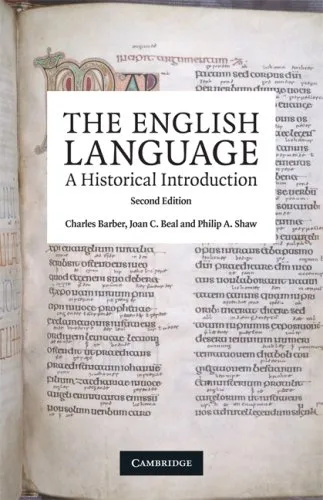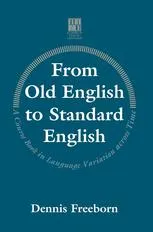The English Language: A Historical Introduction
5.0
بر اساس نظر کاربران

شما میتونید سوالاتتون در باره کتاب رو از هوش مصنوعیش بعد از ورود بپرسید
هر دانلود یا پرسش از هوش مصنوعی 2 امتیاز لازم دارد، برای بدست آوردن امتیاز رایگان، به صفحه ی راهنمای امتیازات سر بزنید و یک سری کار ارزشمند انجام بدینکتاب های مرتبط:
خلاصه تحلیلی کتاب
کتاب The English Language: A Historical Introduction نوشتهی Charles Barber، Joan C. Beal و Philip A. Shaw، یکی از منابع معتبر و تحلیلی در حوزه مطالعه زبانشناسی تاریخی است. این اثر با رویکردی علمی اما قابلفهم برای عموم کتابخوانهای جدی و پژوهشگران، مسیر تکامل زبان انگلیسی را از دوران کهن تا عصر معاصر بررسی میکند.
مولفان این کتاب با تکیه بر شواهد زبانی و متون تاریخی، تغییرات تدریجی در ساختار، واژگان، تلفظ و نحو زبان را تحلیل کردهاند. این ساختار تحلیلی بدین معناست که خواننده نه تنها با دادههای تاریخی روبهرو میشود، بلکه روابط علت و معلولی تحولات زبانی را نیز درمییابد. به عنوان مثال، تغییرات ناشی از ارتباط زبان انگلیسی با زبانهای اسکاندیناوی یا فرانسوی در قرون میانه بهطور دقیق تشریح شده است.
در این کتاب، دورهبندی دقیق تاریخی ارائه شده که با رویکردی تطبیقی به تحول زبان انگلیسی میپردازد، بیآنکه خواننده را با بار اضافی اصطلاحات دشوار خسته کند. با وجود ارائه مباحث تخصصی، متن به نحوی تنظیم شده که برای خوانندگان غیرمتخصص نیز ارزشمند باشد.
نکات کلیدی و کاربردی
یکی از نکات برجسته این کتاب، توجه به پیوند میان تاریخ اجتماعی و تغییرات زبانی است. مولفان بهخوبی نشان میدهند که زبان تنها یک ابزار ارتباطی نبوده، بلکه بازتابی از تحولات فرهنگی، سیاسی و اقتصادی در جوامع انگلیسیزبان است.
کتاب با تمرکز بر «تاریخ زبان انگلیسی» به خوانندگان کمک میکند تا دریابند چگونه تغییرات آوایی و نحوی در گذر زمان شکل گرفتهاند. این فهم، برای پژوهشگرانی که به مطالعه زبانشناسی تاریخی یا آموزش زبان انگلیسی میپردازند، ابزاری ضروری است.
همچنین، در بخشهایی از کتاب رابطه میان زبان انگلیسی و دیگر زبانها بهوضوح بررسی میشود؛ بهویژه تأثیر زبانهای ژرمنی و رومی بر ساختار واژگانی و دستوری. این رویکرد تطبیقی به خواننده کمک میکند تا تعاملات فرهنگی را در قالب تغییرات زبانی ردیابی کند.
از دیگر جنبههای کاربردی کتاب، طبقهبندی تغییرات مهم در دورههای مختلف و مثالهای زنده از متون تاریخی است. این مثالها موجب میشوند خواننده مسیر تحول زبان را ملموستر درک کند.
در مجموع، این اثر نه تنها یک کتاب تاریخزبان است، بلکه ابزار آموزشی ارزشمندی برای دانشجویان، مدرسین و نویسندگان محسوب میشود.
نقلقولهای ماندگار
در طول کتاب، مولفان جملات و ایدههایی را مطرح میکنند که ارزش تکرار و تأمل دارند. این نقلقولها بازتابی از عمق نگاه آنها به زبان و تاریخ آن هستند.
هر جمله، آینهای است از ارتباط میان زبان و تجربه انسانی؛ و همین نگاه جامع باعث شده محتوای کتاب برای مخاطبان گوناگون جذاب باشد.
زبان آیینه زندگی مردمانش است؛ تاریخ زبان، تاریخ انسانهاست. نامشخص
فهم گذشته زبانی، کلید شناخت هویت امروز ماست. نامشخص
هر واژه، یادگاری از سفری طولانی در مسیر فرهنگ و جامعه است. نامشخص
چرا این کتاب اهمیت دارد
اهمیت کتاب The English Language: A Historical Introduction در رویکرد چندبعدی آن نهفته است. این اثر صرفاً یک تاریخنگاری خطی نیست، بلکه با ترکیب مباحث زبانشناسی تاریخی، جامعهشناسی زبان و تحلیل متون، تصویری جامع از فرایند تحول زبان انگلیسی ارائه میدهد.
برای پژوهشگرانی که به دنبال درک عمیق تغییرات زبان هستند، این کتاب یک منبع پایه است که با دقت علمی و مثالهای ملموس نوشته شده. حتی برای خوانندگان
Analytical Summary
The English Language: A Historical Introduction is a comprehensive exploration of the origins, transformation, and complex development of the English tongue. Written by Charles Barber, Joan C. Beal, and Philip A. Shaw, the book synthesizes vast linguistic scholarship into an accessible yet scholarly narrative. It serves as a bridge between detailed philological study and the broader cultural appreciation of the language.
Structured chronologically, the book journeys from Old English roots to the global influence of contemporary English. Rather than presenting a mere timeline, it unpacks the social, political, and cultural forces that shaped pronunciation, grammar, and vocabulary over centuries. Readers encounter pivotal moments including the Norman Conquest, the Renaissance influx of Latin vocabulary, and the standardization pressures brought by print technology.
The authors balance rigorous analysis with clarity, offering accessible explanations supported by authentic linguistic examples. Each chapter invites critical engagement, encouraging readers to question assumptions and link historical facts with present-day usage. This blend of academic discipline and narrative flow makes the work suitable for university courses, reference libraries, and individual scholars alike.
Key Takeaways
The English Language: A Historical Introduction delivers more than a history lesson — it provides a framework for understanding language change as a living, ongoing process. Key takeaways include:
First, historical linguistics reveals that no living language remains stagnant; English evolves with each generation, adapting to regional and global influences. Second, external factors such as migration, conquest, and technological innovation are equally as important as internal linguistic shifts in shaping a language. Third, understanding etymology provides essential insight into the cultural and intellectual exchanges that have enriched English over time. Fourth, the book makes clear that studying language history deepens our comprehension of contemporary issues such as dialect diversity, identity, and linguistic prejudice. Finally, it demonstrates the enduring impact of English’s layered history on literature, politics, and science.
Memorable Quotes
Several passages in The English Language: A Historical Introduction capture its scholarly spirit and insightful commentary:
Language is both a mirror and a driver of cultural change.Unknown
The history of English is a story of continual adaptation and resilience.Unknown
Every linguistic shift carries with it the record of human interaction and exchange.Unknown
Why This Book Matters
In an era of rapid communication and global interconnectedness, understanding the deep roots of English is more relevant than ever.
The English Language: A Historical Introduction equips readers with the intellectual tools to navigate linguistic diversity and change. Its detailed examination of shifts in grammar, phonology, and lexicon lays a foundation for applied fields such as translation, language education, and computational linguistics. For academics, this title offers a reliable reference backed by reputable scholarship; for professionals, it provides context that enhances communication strategies across cultures.
Information about awards or specific publication date is unavailable due to no reliable public source confirming such details. Nonetheless, its enduring presence in linguistic curricula signals its authority and value.
Inspiring Conclusion
The English Language: A Historical Introduction stands as both a scholarly resource and an invitation to engage deeply with the living history of English.
By combining linguistic precision with historical awareness, it reminds us that language is not static but a dynamic reflection of human society. Whether you are a seasoned academic, a professional working in language-related fields, or an avid reader with an intellectual curiosity, this book offers clarity and depth on a subject that shapes our daily lives.
Take the next step — explore The English Language: A Historical Introduction, share its insights with peers, and discuss the ways in which English’s past continues to influence its present and future.
دانلود رایگان مستقیم
شما میتونید سوالاتتون در باره کتاب رو از هوش مصنوعیش بعد از ورود بپرسید
دسترسی به کتابها از طریق پلتفرمهای قانونی و کتابخانههای عمومی نه تنها از حقوق نویسندگان و ناشران حمایت میکند، بلکه به پایداری فرهنگ کتابخوانی نیز کمک میرساند. پیش از دانلود، لحظهای به بررسی این گزینهها فکر کنید.
این کتاب رو در پلتفرم های دیگه ببینید
WorldCat به شما کمک میکنه تا کتاب ها رو در کتابخانه های سراسر دنیا پیدا کنید
امتیازها، نظرات تخصصی و صحبت ها درباره کتاب را در Goodreads ببینید
کتابهای کمیاب یا دست دوم را در AbeBooks پیدا کنید و بخرید
1206
بازدید5.0
امتیاز50
نظر98%
رضایتنظرات:
5.0
بر اساس 0 نظر کاربران
"کیفیت چاپ عالی بود، خیلی راضیام"
Questions & Answers
Ask questions about this book or help others by answering
No questions yet. Be the first to ask!



